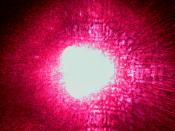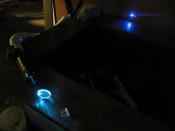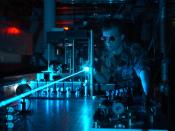There are only about 100 different kinds of atoms in the entire universe. Everything we see is made up of these 100 atoms in an unlimited number of combinations. They continuously vibrate, move and rotate. Even the atoms that make up the chairs that we sit in are moving around in class. Atoms can be in "different states of excitation" (Bertolotti 48) or they can have different energies. If we apply a lot of energy to an atom, it can leave what is called the ground-state energy level and go to an excited level. The level of excitation depends on the amount of energy that is applied to the atom by heat, light, or electricity. An atom consists of a nucleus (containing the protons and neutrons) and an electron cloud. The electrons in this cloud "circle the nucleus in many different orbits" (Bertolotti 51). In other words, if we apply some heat to an atom, we might expect that some of the electrons in the lower energy orbital would shift to higher energy orbitals further away from the nucleus.
Once an electron moves to a higher-energy orbit, it eventually wants to return to the ground state. When it does, it releases its energy as a photon, a particle of light. You see atoms releasing energy as photons all the time. For example, when the wires in a toaster turns bright red, the red color is caused by atoms, excited by heat, releasing red photons. When you see a picture on a TV, what you are seeing is atoms, excited by high-speed electrons, emitting different colors of light. Anything that produces light, such as fluorescent lights and bulbs, does it through the "action of electrons changing orbits and releasing photons" (Bertolotti 51). A laser is a device that controls the way...



Not bad
although it is not a A+ essay it is an A+ essay. First annoying thing I picked out. My second contention is with the lack of paragraphs. Paragraphs = coherence. Content wise it is good, although it is rather descriptive and doesn't have any obvious argument behind it. I would be it an A- myself.
11 out of 11 people found this comment useful.